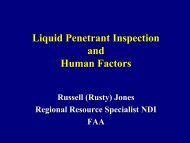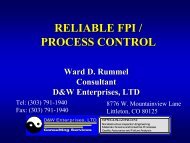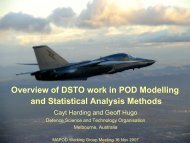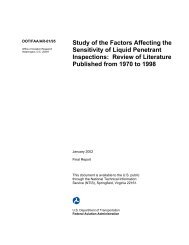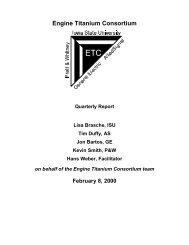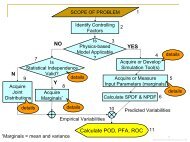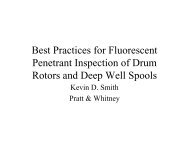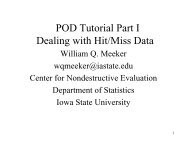Engine Titanium Consortium - Center for Nondestructive Evaluation ...
Engine Titanium Consortium - Center for Nondestructive Evaluation ...
Engine Titanium Consortium - Center for Nondestructive Evaluation ...
You also want an ePaper? Increase the reach of your titles
YUMPU automatically turns print PDFs into web optimized ePapers that Google loves.
the methodology. These may be thought of as approximations to the response surfaces which<br />
avoid executing the full flaw response calculation each time the methodology needs to examine a<br />
new case, thereby greatly speeding up the POD calculation process so that it will proceed at a rate<br />
which will be convenient <strong>for</strong> a user operating in an interactive mode. Selected improvements will<br />
also be made in the flaw and noise response models, supported by data generated in Fundamental<br />
Studies ef<strong>for</strong>t and that has the potential to significantly effect POD. Included will be the effects of<br />
microstructure on the ultrasonic beam profile, and hence, on the distributions of flaw responses;<br />
and the effects of tightly focusing the beam on the distribution of noise. In this latter case, it has<br />
been shown that, when the focal spot size approaches the dimensions of the macrostructure, the<br />
noise distribution is significantly modified. Models were developed in Phase I which described<br />
microstructural effects on noise, but a good means of determining the parameters that are inputs to<br />
the models, i.e., of characterizing the material, have yet to be developed. These procedures will be<br />
developed in Phase II. The laws governing the combinations of signal and noise distributions will<br />
be developed. Once known, these promise to greatly reduce the need <strong>for</strong> experimental<br />
measurements of flaw response to exercise the methodology and hence, should significantly<br />
increase its portability. Finally, the effects of variations in calibration response and uncertainties in<br />
the determination of flaw size on the accuracy of POD determination will be investigated, and the<br />
methodology will be modified as needed to accept these results. Results of all of these software<br />
and procedural advances will be integrated and provided to the OEMs <strong>for</strong> their internal use.<br />
POD <strong>for</strong> <strong>Titanium</strong> Billet - Existent/New Data Analysis, and Use of the CBS: Additional in<strong>for</strong>mation<br />
about the properties of flaws in titanium alloys will be collected and reviewed as it becomes<br />
available. Here, particular attention will be placed on the results <strong>for</strong> large diameter billets. This<br />
in<strong>for</strong>mation will be reviewed and used to update POD estimates <strong>for</strong> ultrasonic inspection of titanium<br />
billet and to extend the POD estimates to cover billets up to 14″ diameter. Included will be a review<br />
of the revised inspection approaches <strong>for</strong> larger diameter billets, the development of any model<br />
modifications required to predict the flaw response <strong>for</strong> those approaches, validation of those models<br />
using calibration standards and chord blocks, and prediction of POD. These predictions will be<br />
compared to those of existent methodologies where the data is sufficient to allow existent<br />
methodologies to be used.<br />
In<strong>for</strong>mation from the responses of the CBS defects will be used with the new methodology to<br />
update POD estimates and provide them to RISC and TRMD. New flaw detection data will be<br />
incorporated into revised estimates of titanium billet POD as they occur, and will provide a basis <strong>for</strong><br />
revising the “default” POD estimates that have been supplied to the AIA Rotor Integrity<br />
Subcommittee (RISC).<br />
In<strong>for</strong>mation from the responses of the CBS defects will be used in three ways. Ten of these defects<br />
will have undergone careful metallographic analysis in Phase I. As noted previously, this<br />
in<strong>for</strong>mation will be a part of the detailed validation of the flaw response models. It will provide input<br />
to tuning the model <strong>for</strong> the response of naturally occurring flaws. Finally, methods will be sought<br />
and implemented to utilize the in<strong>for</strong>mation in the remaining 50 flaws which were not the subject of<br />
destructive metallographic characterization. Here, the approach will be to seek a correlation<br />
between the C-scan image size (available <strong>for</strong> all 60 flaws) and actual defect size available <strong>for</strong> the<br />
ten which have been sectioned. If such a correlation is successful on these 10 defects, it will be<br />
Quarterly Report – January 1, 2002 –March 31, 2002<br />
print date/time: 6/6/2002 - 8:39 AM – Page 88



